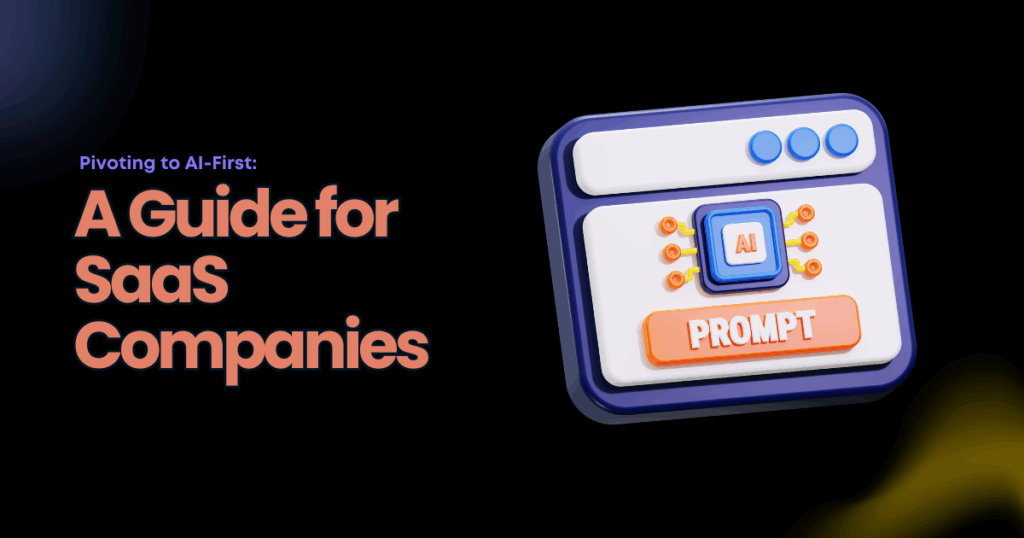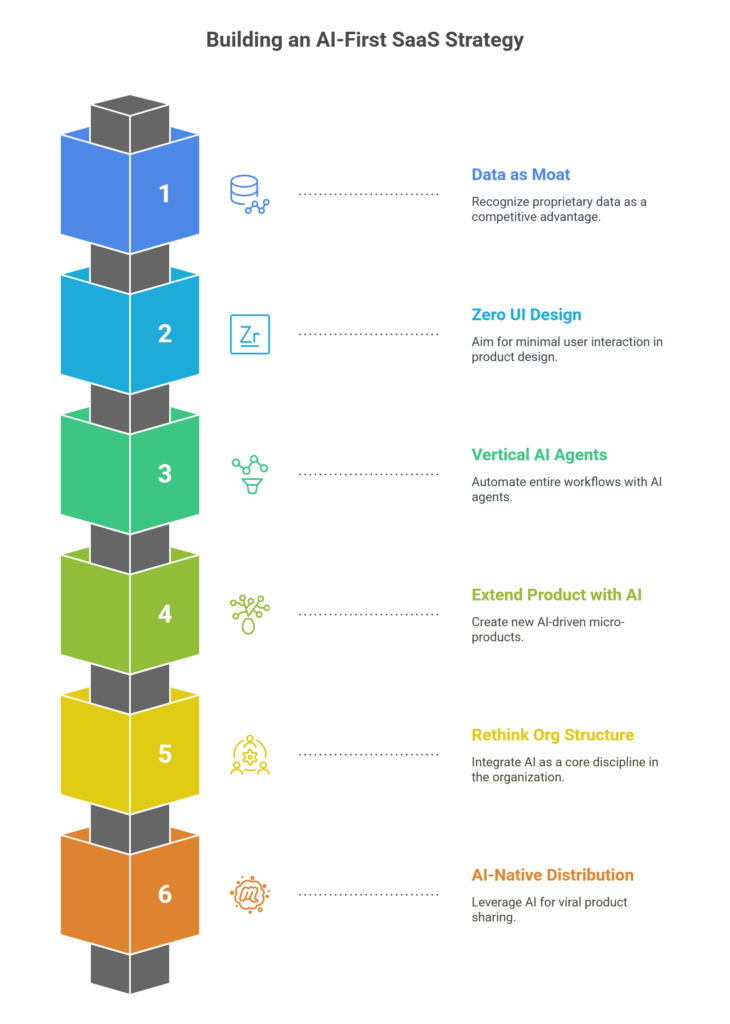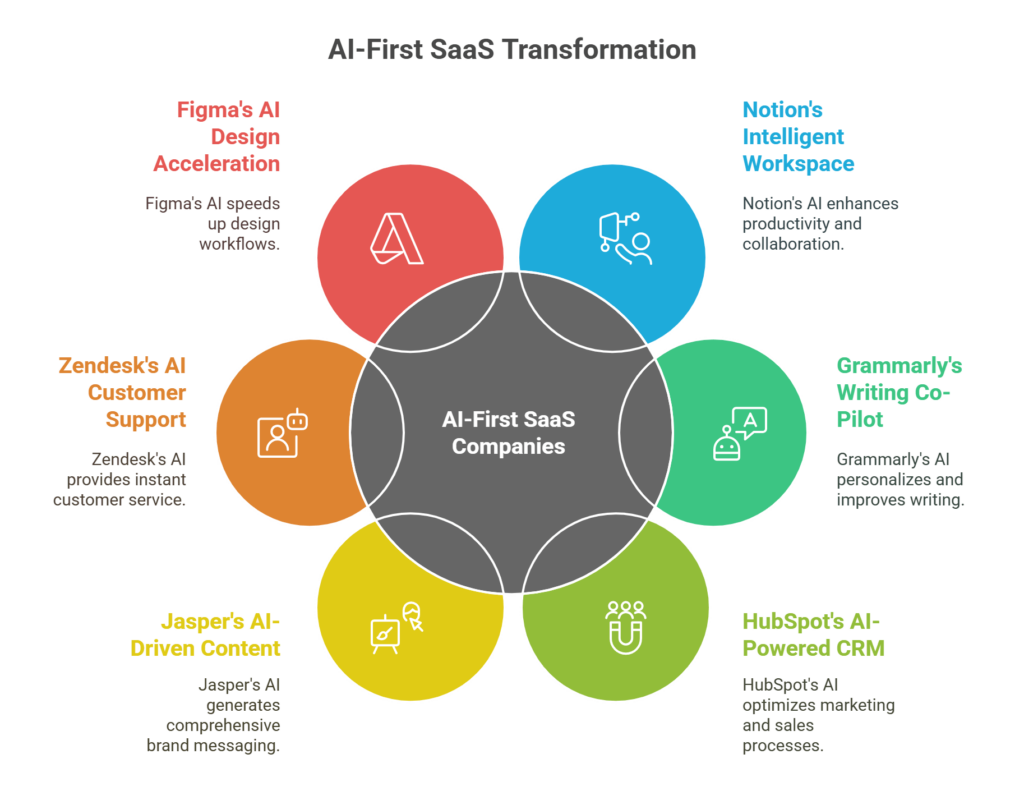
If you’re a SaaS founder, you’re already familiar with disruption. You’ve built your business on the cloud, mastered recurring revenue, and delivered value through beautiful, scalable software. But now, a new wave is redefining what software should be — and it’s not just a feature upgrade. It’s a fundamental shift in how products are built, sold, and used.
That shift is AI.
The companies that are winning right now aren’t just tacking on machine learning to their existing tools. They’re rethinking their entire product around intelligence. They’re using AI to deliver not just software, but outcomes — faster, smarter, and often without the user lifting a finger.
And here’s the hard truth: adding a chatbot or writing assistant doesn’t make you an AI-first business. Pivoting to AI-first means rewiring how your product works, how your team builds, how your customers interact, and how your company delivers value.
This article is for you — the founder thinking about what’s next. We’ll break down what “AI-first” really means, how SaaS companies are making the leap, and what steps you can take to evolve — without burning everything down and starting from scratch.
Let’s get into it.
How can traditional SaaS companies pivot into AI-first businesses?

1. Treat Proprietary Data as a Moat, Not Just an Input
Most AI applications are using similar foundational models (OpenAI, Anthropic, etc.), which means your edge is your data. But most SaaS companies underutilize the unique, proprietary data flowing through their systems.
Founder insight: Start viewing your customer usage data, support tickets, clickstreams, or documents not just as analytics, but as the fuel for fine-tuned, defensible AI models. Build lightweight internal datasets, then fine-tune smaller open-source models for specific tasks. This can outperform generalized LLMs and give you a competitive moat.
2. Design for “Zero UI” Where Possible
The next wave of SaaS isn’t just about better UX — it’s about less UX. In AI-first products, users don’t necessarily want more features — they want fewer decisions.
Founder insight: Explore “invisible” product flows where the AI handles tasks without explicit interaction. For example:
- A marketing platform that drafts campaigns based on performance history, not just templates.
- A financial tool that executes small optimization decisions on behalf of the user — with the option to review, not approve.
Ask: What parts of your product could run without a UI at all?
3. Leverage Vertical AI Agents for Entire Workflows
Instead of adding AI features to individual tasks, identify full end-to-end workflows you can automate using AI agents. For example, rather than just summarizing a sales call, a CRM could:
- Pull in relevant customer history
- Generate a follow-up email
- Update the deal stage
- Notify the account manager with suggested next steps
Founder insight: Bundle multiple micro-decisions into autonomous agents. Then productize them as premium features. This shifts your value proposition from “tools” to “delegation.”
4. Use AI to Extend the Product, Not Just Enhance It
Most SaaS companies use AI to improve the core product. But there’s a massive opportunity in creating entirely new micro-products on top of your data layer.
Founder insight: If you’re a SaaS for e-commerce logistics, could your AI generate real-time procurement forecasts? If you’re a hiring platform, could your AI launch an internal coaching assistant for rejected candidates?
These new “AI-native” experiences can become standalone revenue lines or viral growth loops — all with low marginal cost.
5. Rethink Org Structure Around AI
AI isn’t just a feature layer — it changes how teams operate. Most SaaS companies bolt AI onto the product team. Instead, start treating AI like you treat design or product strategy — a first-class discipline.
Founder insight: Build cross-functional squads with PMs, AI/ML engineers, designers, and domain experts focused on high-impact outcomes. Give them direct access to user data and ownership over key metrics. These teams shouldn’t report to engineering — they should report to the product or innovation lead.
Also: consider creating an “AI Ops” team early, even before you scale. This team ensures models are reliable, fair, and continuously improving — like a DevOps team for intelligence.
6. Invest in AI-Native Distribution
Most founders focus on AI inside the product — few think about how AI changes distribution.
Founder insight: Can your product generate content, reports, or insights that can be automatically published and shared? Think about how:
- Gong shares conversation insights
- Canva shares branded templates
- Jasper generates marketing assets
AI-first products can create infinite surface area for virality. Automate “output” creation so users share your product without even trying. This is your new growth loop.
Bonus Thought: Create a Feedback Flywheel
In SaaS, feedback is manual. In AI-first products, feedback is ambient.
Founder insight: Capture implicit feedback constantly — did the user accept the suggestion? Edit it? Ignore it? That’s your new dataset. Use reinforcement learning techniques (or even simple heuristics) to continuously improve models. If you get this right, your product doesn’t just scale — it evolves.
Real-World Examples: SaaS Companies Embracing the AI-First Shift

1. Notion – From Productivity Tool to Intelligent Workspace
Originally a note-taking and collaboration tool, Notion introduced Notion AI, a built-in assistant that can write, summarize, brainstorm, and translate content. Instead of users starting with a blank page, they now get intelligent suggestions or even full drafts. The AI isn’t just an add-on; it’s becoming central to how users interact with the platform. This shift has helped Notion remain competitive in a crowded productivity space.
AI-First Impact:
- Speeds up writing and content creation
- Helps non-writers become more productive
- Makes the tool feel proactive and adaptive
2. Grammarly – From Grammar Checker to Writing Co-Pilot
Grammarly began as a tool to correct spelling and grammar. With the launch of GrammarlyGO, it became a full-fledged AI writing assistant. It now offers idea generation, tone adjustment, email replies, and personalized suggestions. Grammarly isn’t just fixing mistakes anymore — it’s actively helping users create better content from scratch.
AI-First Impact:
- Deep personalization of writing suggestions
- Context-aware enhancements based on writing goals
- Expansion into new verticals like business communication
3. HubSpot – AI Embedded in CRM and Marketing
HubSpot has evolved from a marketing automation SaaS into an AI-powered customer platform. It now uses AI for content generation, chatbots, lead scoring, and email optimization. Their Smart CRM integrates machine learning to help sales and marketing teams work more efficiently and close deals faster.
AI-First Impact:
- Predictive lead scoring improves sales focus
- AI content assistants speed up marketing workflows
- Smart automation enhances customer experience
4. Jasper – AI-First from Day One
Jasper is a great example of a SaaS company that launched as an AI-first business. It started as a content generation platform for marketers and quickly grew into a comprehensive AI co-pilot for brand messaging. Everything it does — from blog writing to ad copy — is driven by large language models.
AI-First Impact:
- Core product is powered entirely by AI
- Focus on workflows rather than raw features
- Built-in personalization for brand tone and audience
5. Zendesk – Customer Support Meets AI
Zendesk, traditionally known for customer service ticketing, has steadily integrated AI to handle repetitive support queries, route tickets more intelligently, and provide agents with real-time suggested responses. Their AI-powered bots now help customers get instant answers without agent involvement.
AI-First Impact:
- Faster response times and reduced workload on agents
- Intelligent self-service tools for customers
- More efficient ticket prioritization and routing
6. Figma – AI to Accelerate Design Workflows
While still in its early stages with AI, Figma has begun integrating features like auto-layout suggestions, smart design generation, and collaboration enhancements using AI. The direction is clear: helping designers move from idea to mockup faster than ever.
AI-First Impact (Emerging):
- Less manual design tweaking
- Faster prototyping with AI-generated layouts
- Enhanced creative collaboration
What You Can Learn from These Companies
- AI should improve the outcome, not just the interface. Think beyond chatbots — think business results.
- Integration matters. The best AI features are seamless, not bolt-ons.
- The user still comes first. AI should feel like magic, not machinery. It should simplify, not complicate.
Whether you’re a startup or an established SaaS provider, these examples show there’s a roadmap — and the time to start is now.
Final Thoughts
The SaaS-to-AI-first transition isn’t optional for most companies; it’s inevitable. Users are quickly coming to expect smart, adaptive, and proactive tools. Those who don’t evolve risk becoming obsolete.
But the good news is: SaaS companies are in a strong position to lead this change. You already have customers, data, and infrastructure. Now it’s about rethinking your product, investing in AI capabilities, and building with a bold, user-first mindset.
That’s where we come in. Our SaaS development service is designed to help you make this shift seamlessly, from enhancing existing products with AI features to building AI-first solutions from the ground up.
Don’t wait for perfection. Start the shift, one AI feature at a time.
